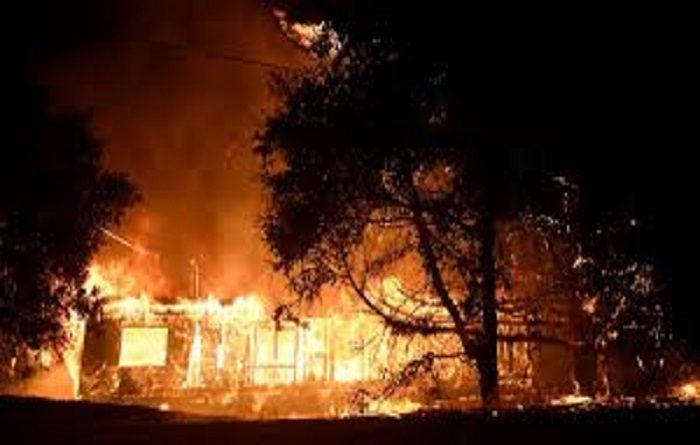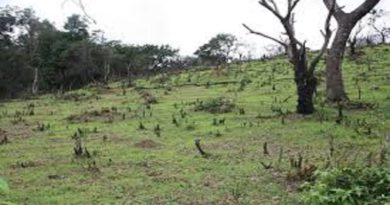UN report identifies looming environmental threats from wildfires, noise pollution, others
Wildfires are burning more severely and more often, urban noise pollution is growing into a global public health menace, and phenological mismatches – disruptions in the timing of life-cycle stages in natural systems – are causing ecological consequences. These critical environmental issues, requiring greater attention, are highlighted in the new Frontiers Report published on Thursday 17 February 2022 by the UN Environment Programme (UNEP).
This is the fourth edition of the Frontiers Report, which was first published in 2016 with an alert to the growing risk of zoonotic diseases, four years before the outbreak of the COVID-19 pandemic.
“The Frontiers Report identifies and offers solutions to three environmental issues that merit attention and action from governments and the public at large,” said Inger Andersen, Executive Director of UNEP. “Urban noise pollution, wildfires and phenological shifts – the three topics of this Frontiers report – are issues that highlight the urgent need to address the triple planetary crisis of climate change, pollution and biodiversity loss.”
The latest edition of the Frontiers report, Noise, Blazes and Mismatches: Emerging Issues of Environmental Concern, is released days before the resumed fifth session of the UN Environment Assembly (UNEA):
Noise pollution in cities is a growing hazard to public health
Unwanted, prolonged and high-level sounds from road traffic, railways, or leisure activities impair human health and well-being. This includes chronic annoyance and sleep disturbance, resulting in severe heart diseases and metabolic disorders such as diabetes, hearing impairment, and poorer mental health.
Noise pollution already leads to 12,000 premature deaths each year in the EU and affects one in five EU citizens. Acceptable noise levels are surpassed in many cities worldwide, including Algiers, Bangkok, Damascus, Dhaka, Ho Chi Minh City Ibadan, Islamabad and New York.
Particularly affected are the very young, the elderly and marginalized communities near high traffic roads, and industrial areas and far from green spaces.
It is also a threat to animals, altering communications and the behaviour of various species, including birds, insects, and amphibians.
At the same time, natural sounds can offer diverse health benefits. Urban planners should prioritize the reduction of noise at the source; investments in alternative mobility; and urban infrastructure that creates positive soundscapes such as tree belts, green walls, green roofs, and more green spaces in cities.
Positive examples include London’s Ultra-Low Emission Zone, Berlin’s new cycle lanes on wide roads, and Egypt’s national plan to combat noise.
COVID-19 lockdowns brought a new appreciation for green spaces and the reduction of urban traffic noise. Programmes meant to ‘build back better’ represent an under-utilized opportunity for policymakers, urban planners and communities to create additional green spaces for all.
Dangerous wildfire weather is projected to get worse
Each year, between 2002 and 2016, an average of about 423 million hectares or 4.23 million square km of the Earth’s land surface – an area about the size of the entire European Union – burned, becoming more common in mixed forest and savannah ecosystems. An estimated 67% of the annual global area burned by all types of fires, including wildfires, was on the African continent.
Dangerous wildfire weather conditions are projected to become more frequent and intense and to last longer, including in areas previously unaffected by fires. Extremely intense wildfires can trigger thunderstorms in smoke flumes that aggravate fires through erratic wind speeds and generate lightning that ignites other fires far beyond the fire front, a hazardous feedback loop.
This is due to climate change, including hotter temperatures and drier conditions with more frequent droughts. Land-use change is another risk factor, including commercial logging and deforestation for farms, grazing land, and expanding cities. A further cause for the proliferation of wildfires is the aggressive suppression of natural fire, which is essential in some natural systems to limit the amounts of combustible material, and inappropriate fire management policies that exclude traditional fire management practices and indigenous knowledge.
Long-term effects on human health extend beyond those fighting wildfires, evacuated, or suffering losses. Smoke and particulate matter from wildfires deliver significant consequences for health in downwind settlements, sometimes thousands of kilometres from the source, with impacts often exacerbated among those with pre-existing illness, women, children, the elderly and the poor. Changes in fire regimes are also expected to lead to massive biodiversity loss, endangering over 4,400 terrestrial and freshwater species.
Wildfires generate black carbon and other pollutants that can pollute water sources, enhance the melting of glaciers, cause landslides and large-scale algal blooms in oceans, and turn carbon sinks such as rainforests into carbon sources.
The report calls for greater investment in reducing the risks of wildfires; development of prevention and response management approaches that include vulnerable, rural, traditional and indigenous communities; and further refinements in remote sensing capabilities, such as satellites, radar and lightning detection.
Climate change disrupts natural rhythms in plants and animals
Phenology is the timing of recurring life cycle stages, driven by environmental forces, and how, within an ecosystem, interacting species respond to the changing conditions. Plants and animals in terrestrial, aquatic and marine ecosystems use temperature, day-length or rainfall as cues for when to unfold leaf, flower, bear fruit, breed, nestle, pollinate, migrate or transform in other ways.
Phenological shifts occur when species shift the timing of life cycle stages in response to changing environmental conditions altered by climate change. The concern is that interacting species in an ecosystem do not always shift the timing in the same direction or at the same rate.
These phenological shifts are increasingly disturbed by climate change, pushing plants and animals out of synch with their natural rhythms and leading to mismatches, such as when plants shift life cycle stages faster than herbivores.
Long-distance migrants are particularly vulnerable to phenological change. Local climatic cues that normally trigger migration may no longer accurately predict conditions at their destination and resting sites along the route.
Phenological shifts in crops in response to seasonal variations will be challenging for food production in the face of climate change. Shifts in the phenology of commercially important marine species and their prey have significant consequences for stock and fisheries productivity.
The full impacts of phenological mismatches require further research. Maintaining suitable habitats and ecological connectivity, strengthening the integrity of biological diversity, coordinating international efforts along migratory routes, supporting resilience and maintaining genetic variation within species are crucial conservation goals. Above all, limiting the rate of warming by reducing CO2 emissions is essential.




